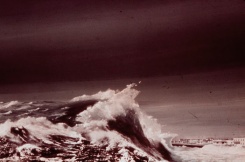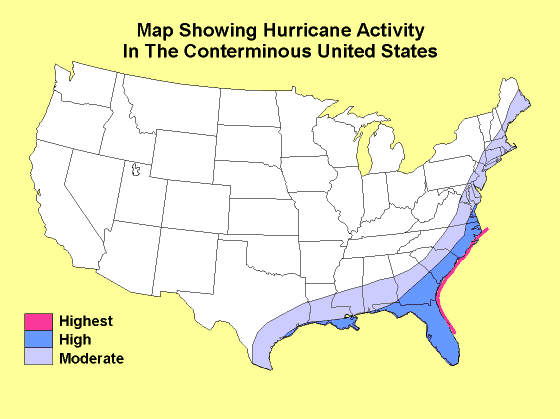Hurricane Risk and HazardsThe Saffir-Simpson hurricane intensity scale is used to classify hurricanes. Though much damage from hurricanes is due to the strong wind and tornadoes they often spawn when making land fall, it is the storm surge that creates the most. The storm surge is the high water level that accompanies a hurricane as it comes ashore. The storm surge is created by the force of the wind pushing up the water level. Storm surges cause flooding of low lying areas and much damage to property and life. Weak hurricanes can produce storm surges of 3 to 6.5 feet (1 to 2 meters), while intense systems can create high water levels of over 16.5 feet (5 meters). The Bathurst Bay hurricane produced a 42 ft (13 m) surge in Bathurst Bay, Australia in 1899. 2005’s Hurricane Katrina poured a 25 ft (7.6 m) storm surge across Bay St. Louis, Mississippi.
Flooding from a hurricane storm surge that hit Galveston, Texas on September 8, 1900 killed 6,000 people. On November 13, 1973 the vast coastal plain of Bangladesh was inundated with storm surge flooding that claimed an estimated 300,000 lives by drowning.
Figure 8.36 Video: Hurricane Storm Surge The storm surge is only a portion of the total water level associated with a hurricane. The normal rise and fall of tides affect the severity of the storm surge. The highest storm surges occur with an incoming high tide. Wave run up adds to the water level along a coast. Heavy rainfall before the hurricane causes freshwater river levels to rise and leads to widespread flooding. Such was the case when Hurricane Sandy’s nearly 4.23 m (13.88 ft) surge sent the East River in New York over its banks, flooding large sections of lower Manhattan. Huge waves crashed on the shores carrying massive amounts of eroded sand into beachfront communities like Seaside Heights, New Jersey (Figure 8.37). Figure 8.37. Impact of Hurricane Sandy’s Storm Surge on Seaside Heights, N.J. Hurricane risks to the United StatesThe greatest risk for hurricanes in the United States is for those living along the southeastern Atlantic seaboard where the warm waters of the Gulf stream provides fuel for storms. Hurricanes rarely affect the west coast with only four storms striking California in the last hundred years. Storms that do affect the west coast are usually remnants of tropical cyclones. Two primary reasons for so few incidences of tropical cyclones are cool coastal waters and the the direction of the prevailing winds. The presence of cold coastal water inhibits the formation or diminishes the strength of any storm that approaches land. Water temperatures along the coast of southern California rarely rise above 24 °C (75 °F) and usually don't get above 17 °C (63 °F). The upper level steering winds in the eastern Pacific winds move storms away from the coast. Tropical cyclones in the eastern Pacific generally move north-westward or westward due to steering by the prevailing upper level winds, which takes them far out to sea and away from the west coast of North America. Many living inland from the coast may feel relatively secure from the ravages of a hurricane. But as it moves onshore, severe thunderstorms, lightning, and tornadoes becomes a threat. Figure 8.38 Hurricane risk for the United States
|


